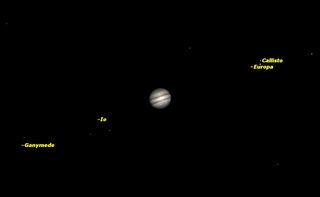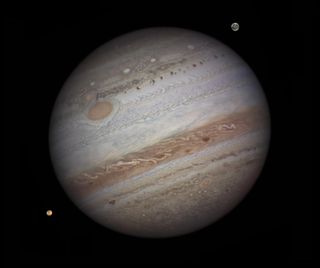
The brilliant planet Jupiter has been attracting a great deal of skywatching attention lately, even from within brightly lit cities.
Look for this dazzling, silver-white object of magnitude minus 2.5 more than halfway up in the east-southeast sky as it darkens in the evening. Jupiter appears three times brighter than Sirius, the brightest star in the night sky, and is the most luminous "star" in the sky after Venus, inviting inspection the moment you set up a telescope.
Presently, Jupiter can be found within the faint stars of Cancer the Crab. Sadly, the plague of light pollution is robbing us of our celestial heritage, and poor Cancer is one of the victims. The Crab is difficult, if not impossible, to see under a light-polluted sky because it contains no star brighter than 4th magnitude. So, it's actually not very helpful to say that Jupiter is "found" among the stars of Cancer, as the constellation is tougher to spot than the planet! [Best Night Sky Events for March (Sky Maps)]
An enormous ball of gas
Jupiter is an enormous ball of hydrogen and helium that's 88,846 miles (142,984 kilometers) in diameter and lacks any solid surface. It has an overall mass nearly 318 times that of the Earth and 2.5 times the mass of all of the other planets combined. In many respects, Jupiter is more like a star than a planet.
"Big Jupe" has often been called "the amateur astronomer's planet." It has the largest apparent disk of any bright object in the sky after the moon and the sun. Its dark belts and bright zones, with their subtle markings — and, of course, its four large and bright moons, first observed by Galileo Galilei in 1610 — make Jupiter a perpetual center of interest.
The cloud bands, which can be glimpsed even with a small telescope, cross the disk of the planet parallel to its equator. Jupiter's disk, incidentally, appears a bit flattened at the poles because the planet is turning so fast on its axis. (It completes a full rotation in less than 10 hours.)
In a moderately large telescope, Jupiter resolves into a series of yellowish, tan and brown shadings, and a wealth of other details can be seen as well. Vast dark belts merge with one another or sometimes fade to insignificance. Brighter zones — actually smeared bands of ammonia clouds — vary in intensity and frequency, and are carved up with dark loops or rifts called festoons.
Get the Space.com Newsletter
Breaking space news, the latest updates on rocket launches, skywatching events and more!
The famous Great Red Spot is the most conspicuous and longest-lived structure on Jupiter's surface. Scientists believe that the spot is a towering vortex whose color might perhaps be due to complex compounds that are constantly spewed from some heated atmospheric source below.
The spot's appearance has changed over the years. About half a century ago, it indeed looked like a prominent brick-red feature on the planet's disk. Nowadays, however, it appears to be lighter in contrast and appears more pinkish or salmon-colored. [Photos: Jupiter, the Solar System's Largest Planet]
The Galilean moons
Jupiter has more than 60 known moons. The planet's four Galilean moons — Io, Europa, Ganymede and Callisto —derive their names from the lovers of Zeus. (Zeus is the Greek equivalent of Jupiter, the king of gods in Roman mythology.)
The Galilean moons are among the most massive objects in the solar system — with the exception of the sun and the eight planets — and are even larger than the dwarf planets Pluto and Ceres. Ganymede is the largest moon in the solar system, and is even bigger than the planet Mercury. All four Galilean moons are bright enough that they could, if they were farther away from Jupiter, be sighted from Earth without a telescope. In fact, some people with exceptionally acute vision claim that they can glimpse the moons without the aid of binoculars or a telescope.
As they circle around Jupiter in paths turned nearly edgewise to the Earth, the Galilean moons appear to swing back and forth, nearly always staying in line. They can be followed for hours, even through binoculars. Through a telescope, you can watch as they speed in front of Jupiter, throwing their shadows on the planet, or vanish behind its disk or suddenly become eclipsed by its shadow. Currently, we are in an unusual cycle in which the moons occasionally will be seen to cross in front of each other, called "mutual" eclipses.

One amateur astronomer who assiduously keeps track of the happenings on Jupiter is Christopher Go, who resides in the Philippines. He would like to invite you to check out some of his amazing images of Jupiter on his website: http://astro.christone.net/jupiter
Editor's note: If you have an amazing skywatching photo of Jupiter or any other night-sky view you'd like to share for a possible story or image gallery, please contact managing editor Tariq Malik at spacephotos@space.com.
Joe Rao serves as an instructor and guest lecturer at New York's Hayden Planetarium. He writes about astronomy for Natural History magazine, the Farmer's Almanac and other publications, and he is also an on-camera meteorologist for News 12 Westchester, New York. Follow us @Spacedotcom, Facebook or Google+. Originally published on Space.com.
Join our Space Forums to keep talking space on the latest missions, night sky and more! And if you have a news tip, correction or comment, let us know at: community@space.com.

Joe Rao is Space.com's skywatching columnist, as well as a veteran meteorologist and eclipse chaser who also serves as an instructor and guest lecturer at New York's Hayden Planetarium. He writes about astronomy for Natural History magazine, the Farmers' Almanac and other publications. Joe is an 8-time Emmy-nominated meteorologist who served the Putnam Valley region of New York for over 21 years. You can find him on Twitter and YouTube tracking lunar and solar eclipses, meteor showers and more. To find out Joe's latest project, visit him on Twitter.
